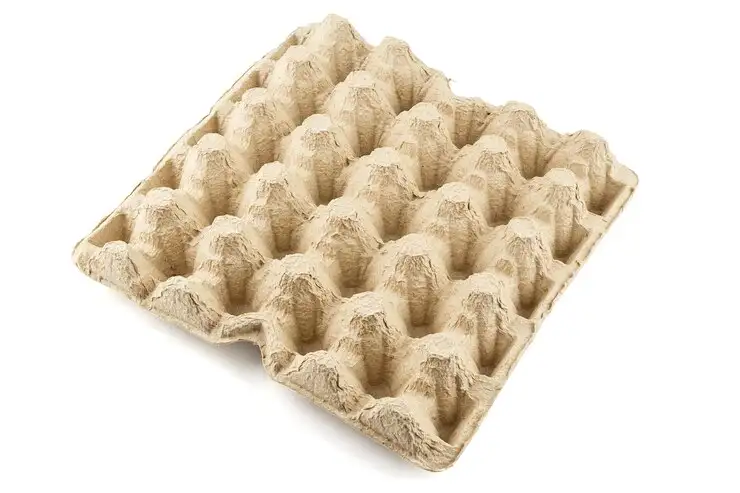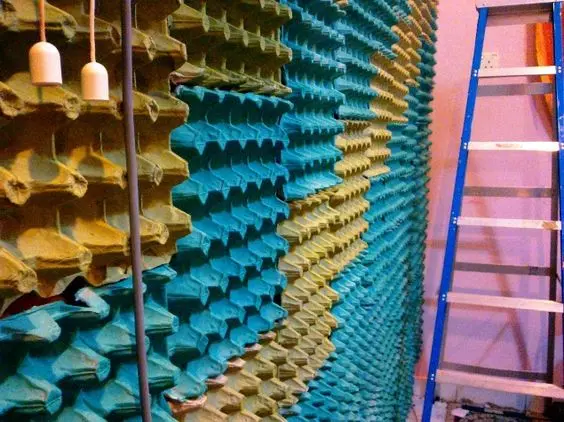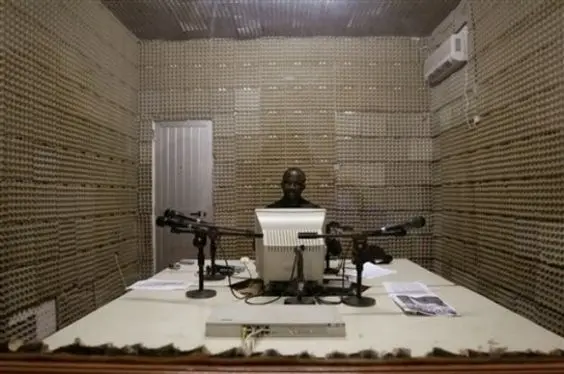How to Soundproof a Room with Egg Cartons? Is it even work?

Sometimes, people get creative to make things sound better. One interesting idea is using egg cartons for soundproofing. This topic has gained some attention over time.
You might have heard that egg boxes, with their unique shape, could possibly help make a room quieter.
But, it’s important to figure out what’s real and what’s not, and understand the science behind soundproofing.
In this article, we’ll explore the common belief that egg cartons are a DIY solution for soundproofing, and we’ll uncover whether they truly live up to this reputation. And, Are egg trays really good for soundproofing a room?
Let’s dive in…
Do egg cartons really work for soundproofing?

Some people think that egg cartons can help with sound because of their shape and bumpy texture, which might scatter sound waves and make noise less loud.
However, while egg boxes might have a small impact on sound diffusion, they aren’t designed for soundproofing.
Egg cartons are made from lightweight materials like cardboard or paper, which are not well-suited for soundproofing.
Effective soundproofing involves using materials that can absorb, reflect, or block sound waves, and egg cartons don’t have the density or acoustic properties required to do so effectively.
However, egg cartons can slightly reduce echo and reverberation in a room due to their irregular surfaces, but they won’t significantly reduce noise transmission between rooms or from external sources.
So, the simple answer is that egg cartons can help a bit with soundproofing, but not in a big way. They’re better at reducing echo and bouncing sound inside a room.
A test done by a YouTube channel Soundproof Guide showed that egg trays can help with echo in a room. (watch the video)
How effective are egg cartons for soundproofing?

In our test, we found that using egg cartons can reduce the noise level by about 4 decibels (dB). To put this in perspective, a reduction of 4 dB is generally perceived as a noticeable but not significant change in loudness.
To figure out how much noise can egg cartons reduce, first, we put a sound box outside of a room and checked the noise level in the room.
It was around 75 dB. Then we put 12 egg cartons on the wall of the room and we did the test again. This time, we noticed the noise level was around 70 to 71 dB.
Can you use egg cartons for soundproofing a room?
Using egg cartons for soundproofing isn’t the best idea, but it can be an option if you don’t have much money to spend or if you just want to make a room sound less echoey.
However, before you go ahead, it’s important to know the good and bad sides of using egg cartons for sound insulation.
Pros and cons of using egg cartons for soundproofing
How to soundproof egg cartons for soundproofing a room effectively?

Here how you can effectively use egg boxes for soundproofing in a room.
Step 1: Measure the Area of the Room
Before beginning the soundproofing process, measure the dimensions of the room you want to soundproof. Calculate the square footage by multiplying the length and width of the room. This measurement will help you determine the number of egg cartons you’ll need.
Step 2: Gather Egg Cartons
Now you know how many egg cartons you will need, it’s time to collect enough egg cartons to cover the surfaces you want to soundproof. You can source them from friends, family, or purchase them online or at a local store.
Depending on the size of the area, you might need around 100 or more egg cartons to cover the entire wall of a small room for proper soundproofing.
Step 3: Collect Essential Materials & Tools
After collecting the egg cartons, you will need to gather some other materials and tools. These include:
- Glue or adhesive
- Wallpaper paste (if using)
- Utility knife or scissors
- Staple gun and staples
- Absorbent material (shredded paper, cotton balls)
If you plan to use additional soft materials like blankets, cardboard, or paper, affix them to the wall before attaching the egg cartons.
Step 4: Prepare the Egg Cartons
This is a very simple task, but crucial to do properly. Prepare the egg cartons by cutting off the tops with a sharp knife or scissors.
Open each carton gently to create a cup shape and fill the cartons with absorbent material to enhance their effectiveness.
This can be anything from shredded paper to cotton balls. Make sure to pack them tightly so that there are no gaps
Step 5: Prepare the Wall
Before you put the egg cartons on your wall, there is one more thing to do and that’s to prepare your wall. This step is also important for soundproofing with egg cartons.
Remove any pictures, posters, or other decorations from the wall you want to install the egg cartons. Then, clear the dirt, dust and debris from the wall using a soft brush.
And if you are concerned for the walls of your room, cover them with a layer of cardboard before attaching the egg cartons.
Just buy some good quality cardboard and attach them to the wall and do not use any glue or tape to attach them, use mini kills because any glue on the tape can spoil your room’s wall.
Step 6: Attach the Egg Cartons
Once you prepare your wall, it’s time to attach egg cartons to the wall! Follow these steps to attach the egg cartons to the wall:
- Apply adhesive to the back of each egg carton. A hot glue gun is recommended.
- Begin by applying glue to one egg carton at a time.
- Press the egg carton firmly against the wall, ensuring good adhesion.
- Repeat the process, carton by carton, until the desired area is covered.
- Allow the adhesive to dry for 6 to 8 hours for optimal results.
After drying, inspect for any gaps or spaces and fill them with additional absorbent material, such as cotton. And this is it, now you have successfully soundproofed your room using egg trays.
Best egg crate alternatives for soundproofing a room
Relying solely on egg cartons for soundproofing your room, might not provide the result you are looking for. So using egg trays with other materials will be best.
Here are some of the best soundproofing materials that you can use with egg boxes or as an alternative.
- Acoustic Foam Panels: Acoustic foam panels are the best alternative for egg cartons. These panels are more effective than egg crates. Acoustic panels offer excellent sound absorption and diffusion properties. You can easily mount these panels on walls and ceilings to minimize echoes and improve sound quality.
- Fiberglass Insulation: According to soundproofcow.com, fiberglass insulation is a sound absorbing material that works to absorb sound and reduce their impact. It’s mostly used in construction and can be installed within walls or ceilings for soundproofing your room.
- Cork Panels: According to panelscreen.co.uk, cork panels have natural qualities that make it a good option for reducing noise. They are effective at sound absorption and diffusion as well, making them a unique alternative to egg cartons.
- Soundproof Curtains: I am sure you already know what soundproof curtains are. They’re a cost-effective solution for soundproofing door and window soundproofing. A quality curtain with multiple layers can reduce the noise level by up to 29 dB. (read the full post)
Read: What is the best sound reduction curtain?
Frequently Asked Questions
Q1. How do egg cartons improve sound insulation?
Egg cartons have a textured surface that can help scatter sound waves, preventing them from bouncing directly back into the room and reducing noise a little bit.
Q2: Are there specific types of egg cartons that work best for soundproofing?
You can use any egg carton , but those with deeper cups or ridges tend to be more effective in dispersing sound waves.
Q3: Are there any creative or unique ways to use egg cartons for soundproofing?
One creative approach is to create soundproofing panels by attaching egg cartons to wooden frames covered with fabric. This adds an aesthetic touch while enhancing sound insulation.
Q4: What other materials can I use instead of (or in addition to) egg cartons?
You can use acoustic foam panels, fiberglass insulation, mass-loaded vinyl, soundproof curtains, and acoustic tiles in addition to, or instead of, egg cartons. Each material has its own advantages and some shortcoming as well, so it’s important to choose the right one based on your specific soundproofing needs and budget.
Q5: Why don’t Professional Acousticians use egg cartons?
Professional acousticians do not use egg cartons for soundproofing because they are not as effective as other sound-absorbing materials specifically designed for that purpose. Egg cartons are a DIY option that can help reduce noise, but they are not the most efficient solution for acoustical treatment. Plus, they’re not very attractive, So they are afraid that the looks of their house may not be erased.
Conclusion
Using egg cartons for soundproofing a room might seem interesting, but it’s not the best way for this purpose. Egg cartons have bumpy surfaces that can help spread out sound waves, reducing echoes.
But they’re not heavy enough to really stop or absorb the noise properly. So, they won’t do a great job at stopping loud sounds from outside or between rooms.
A test conducted by the SoundproofAddict team found that using egg cartons can result in a reduction of noise level by about 4 decibels (dB). This indicates that egg cartons can have a minor impact on sound reduction.
For a more effective soundproofing strategy, it’s advisable to consider using other materials such as acoustic foam panels, fiberglass insulation, mass-loaded vinyl, soundproof curtains, and acoustic tiles.
If you are using egg cartons for soundproofing a room then consider using other soundproofing materials.
Professional acousticians typically avoid using or don’t rely solely on egg cartons due to their poor effectiveness compared to other soundproofing materials.
